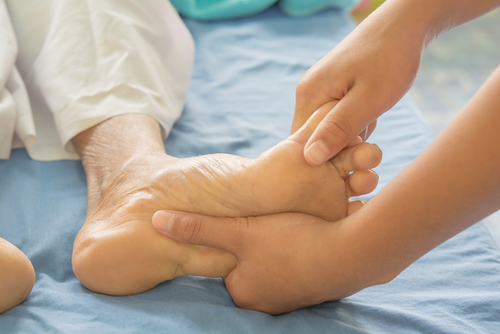What Is Manual Manipulation?
Monday, 19 October 2020 00:00Cuboid syndrome is a condition in which the cuboid bone in the foot is moved out of its proper place, usually due to injury. This condition typically causes pain in the foot. One common treatment for cuboid syndrome is manipulation, in which the doctor applies pressure to the cuboid bone to move it back to the correct position. There are several different types of manipulation. One example is the cuboid “whip” technique, which requires the patient to lie on their stomach with the knee of the affected foot flexed at a 70 to 90 degree angle and the ankle relaxed in a neutral position. The doctor interlocks their fingers over the top surface of the foot and then applies pressure with their thumbs to the bottom surface of the foot. They then perform a quick thrust directed towards the top of the foot. This process may help set the cuboid back in the right position. If you have cuboid syndrome, please consult with a podiatrist, who can perform manipulations and other treatments for this condition.
Cuboid syndrome, also known as cuboid subluxation, occurs when the joints and ligaments near the cuboid bone in the foot become torn. If you have cuboid syndrome, consult with Joseph D. Ruffo, DPM, PC from New York. Our doctor will assess your condition and provide you with quality foot and ankle treatment.
Cuboid syndrome is a common cause of lateral foot pain, which is pain on the outside of the foot. The condition may happen suddenly due to an ankle sprain, or it may develop slowly overtime from repetitive tension through the bone and surrounding structures.
Causes
The most common causes of cuboid syndrome include:
- Injury – The most common cause of this ailment is an ankle sprain.
- Repetitive Strain – Tension placed through the peroneus longus muscle from repetitive activities such as jumping and running may cause excessive traction on the bone causing it to sublux.
- Altered Foot Biomechanics – Most people suffering from cuboid subluxation have flat feet.
Symptoms
A common symptom of cuboid syndrome is pain along the outside of the foot which can be felt in the ankle and toes. This pain may create walking difficulties and may cause those with the condition to walk with a limp.
Diagnosis
Diagnosis of cuboid syndrome is often difficult, and it is often misdiagnosed. X-rays, MRIs and CT scans often fail to properly show the cuboid subluxation. Although there isn’t a specific test used to diagnose cuboid syndrome, your podiatrist will usually check if pain is felt while pressing firmly on the cuboid bone of your foot.
Treatment
Just as the range of causes varies widely, so do treatments. Some more common treatments are ice therapy, rest, exercise, taping, and orthotics.
If you have any questions, please feel free to contact one of our offices located in Sea Cliff and Babylon, NY . We offer the newest diagnostic and treatment technologies for all your foot care needs.





